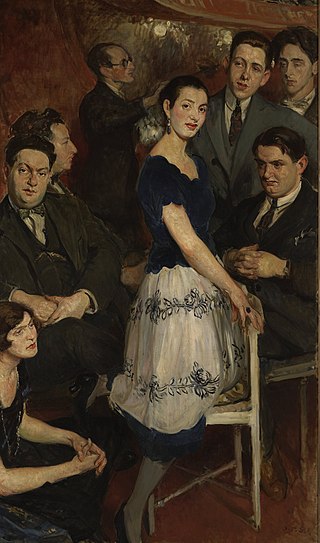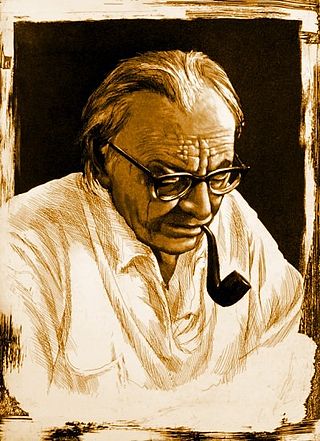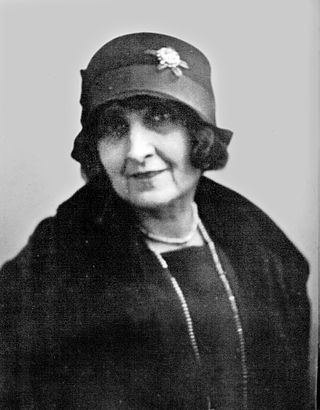You can help expand this article with text translated from the corresponding article in German. (November 2011)Click [show] for important translation instructions.
|
Comoedia Mundi is a touring theatre group in Bavaria, Germany. [1]
You can help expand this article with text translated from the corresponding article in German. (November 2011)Click [show] for important translation instructions.
|
Comoedia Mundi is a touring theatre group in Bavaria, Germany. [1]

"Les Six" is a name given to a group of six composers, five of them French and one Swiss, who lived and worked in Montparnasse. The name has its origins in two 1920 articles by critic Henri Collet in Comœdia. Their music is often seen as a neoclassic reaction against both the musical style of Richard Wagner and the Impressionist music of Claude Debussy and Maurice Ravel.

A mappa mundi is any medieval European map of the world. Such maps range in size and complexity from simple schematic maps 25 millimetres or less across to elaborate wall maps, the largest of which to survive to modern times, the Ebstorf map, was around 3.5 m in diameter. The term derives from the Medieval Latin words mappa and mundus (world).

De temporum fine comoedia is a choral opera-oratorio by 20th-century German composer Carl Orff. His last large work, and a personal one, it took ten years to compile the text and another two years to compose ; he revised it in 1979 and again in 1981. Orff presents a mystery play summarizing his view of the end of time sung in Ancient Greek, Latin, and a German translation by Wolfgang Schadewaldt. De temporum fine comoedia was recorded before it was premiered. Herbert von Karajan conducted sessions from 16 to 21 July 1973 in a studio in Leverkusen-Wiesdorf, employing three choruses and the Cologne Radio Symphony Orchestra. The public and stage premiere took place at the Salzburg Festival a month later, on 20 August, with the same forces and stage direction by August Everding.
Anima Mundi is a competitive Brazilian video and film festival devoted exclusively to animation, held every July in the cities of Rio de Janeiro and São Paulo, Brazil.

The Études-Tableaux, Op. 39, is the second of two sets of piano études composed by Sergei Rachmaninoff. Op. 39 was composed sometime between 1916 and 1917 and were among the final works composed by Rachmaninoff before his exit from Russia.

Egon Freiherr von Eickstedt was a German physical anthropologist who classified humanity into races. His study in the classification of human races made him one of the leading racial theorists of Nazi Germany.

Harmonia Mundi is an independent record label that specializes in classical music, jazz, and world music. It was founded in France in 1958 and is now a subsidiary of PIAS Entertainment Group.

Andreas Walsperger was a German cartographer of the 15th century. The son of a carpenter, he became a Benedictine monk at St. Peter's in Salzburg in 1434. He left the monastery in 1442. Little more is known about him except that in 1448/9 he created his map in Konstanz.

Calpe, also Kalpas or Calpas, was a port city of ancient Bithynia in Asia Minor, on the shore of the Black Sea. It was located not far from the mouth of the river Calpas. It was mentioned in Xenophon's Anabasis. Xenophon, who passed through the place on his retreat with the Ten Thousand, describes it as about halfway between Byzantium and Heraclea Pontica on a promontory, part which projects into the sea is an abrupt precipice. The neck which connects the promontory with the mainland is only 400 feet (120 m) wide. The port is under the rock to the west, and has a beach; and close to the sea there is a source of fresh water. The place is minutely described by Xenophon. The place is mentioned also by Pliny the Elder, Solinus, Arrian, who places it 210 stadia from the mouth of the Psilis, and Stephanus of Byzantium.

François-Xavier Paul Roth is a French conductor.
Imago Mundi, or in full Imago Mundi: International Journal for the History of Cartography, is a semiannual peer-reviewed academic journal about mapping, established in 1935 by Leo Bagrow. It covers the history of early maps, cartography, and map-related ideas. Articles are in English and have abstracts in French, German, Spanish, and English. Each volume also contains three reference sections that provide a summary of current developments in the field.
The earliest cartographic depictions of Europe are found in early world maps. In classical antiquity, Europe was assumed to cover the quarter of the globe north of the Mediterranean, an arrangement that was adhered to in medieval T and O maps.
René Clemencic was an Austrian composer, conductor, harpsichordist, clavichordist and recorder player.

Salvator Mundi is a painting attributed in whole or part to the Italian High Renaissance artist Leonardo da Vinci, dated c. 1499–1510. Long thought to be a copy of a lost original veiled with overpainting, it was rediscovered, restored, and included in an exhibition of Leonardo's work at the National Gallery, London, in 2011–2012. Christie's, which sold the work in 2017, stated that most leading scholars consider it an original work by Leonardo, but this attribution has been disputed by other leading specialists, some of whom propose that he only contributed certain elements; others believe that the extensive restoration prevents a definitive attribution.

Plocaederus is a genus of Long-Horned Beetles in the beetle family Cerambycidae. This genus has a single species, Plocaederus bellator. It is known from the South American countries Brazil, Ecuador, Guyana, French Guiana, Paraguay, and Suriname.
HeinrichsWeikamp, based in Germany, is a company that produces sports precision instruments for scuba diving including personal dive computers and oxygen partial pressure monitors for diving rebreathers.

Jeanne-Henriette Tirman was a French woman painter and printmaker.

Sonia Lewitska was a Ukrainian-born French painter and printmaker.

Comœdia was a French literary and artistic paper founded by Henri Desgrange on 1 October 1907. It published a number of texts by important literary figures, including Antonin Artaud's first publication on theatre, L'évolution de décor [The Evolution of Decor] (1924).:602 According to Richard Abel, it provides one of the most complete sources of cultural history in France just prior to World War I.

The Ensemble Resonanz is a German string ensemble that combines the performance and promotion of Neue Musik with the interpretation of classical repertoire. It sees itself at the interface between chamber orchestra and soloist ensemble for Neue Musik. The ensemble is based in Hamburg, where it is an Ensemble in Residence of the Elbphilharmonie.